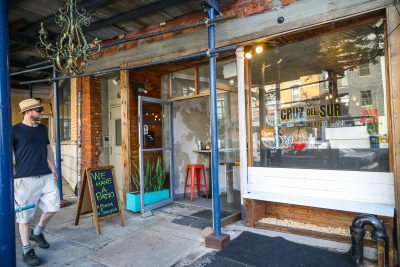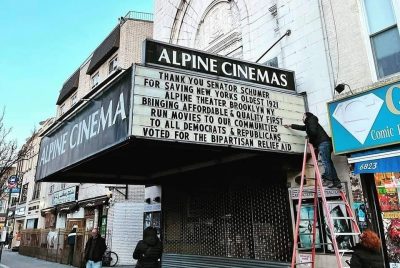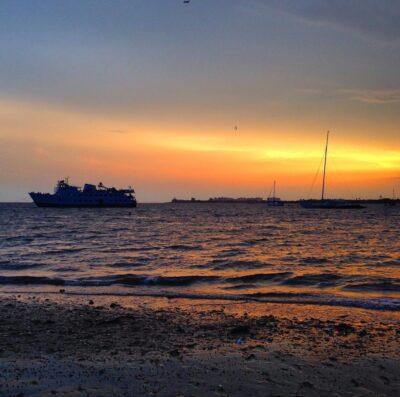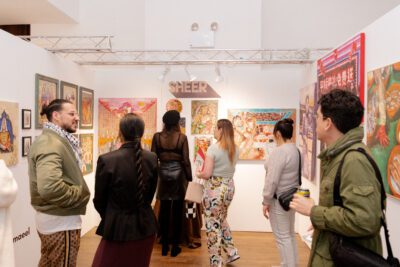Christmas in Springtime: Talking with Director Charles Poekel About His Film Christmas, Again
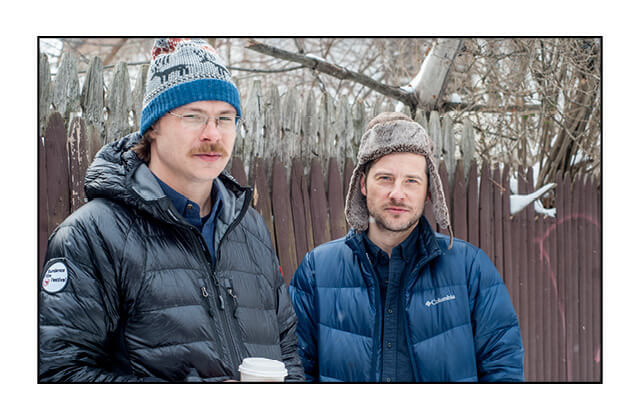
Charles Poekel and Kentucker Audley
photo by Jane Bruce
An intimate, hand-made film, Charles Poekel’s Christmas, Again has the sort of lovelorn sensibility that aligns with the previous century’s yuletide tales. At once highly specific to its Greenpoint location and readily accessible to just about any admirer of diligent character studies, Christmas concerns Noel (Kentuckey Audley), a lonesome Christmas tree salesman, who returns to Brooklyn for the holiday season following a breakup, all beautifully rendered by Sean Price Williams’ 16mm cinematography. When he comes across a young woman (Hannah Gross) unconscious on a park bench, his one-note evenings unravel into something much more stimulating, though not always for the better. We spoke with Poekel at the Sundance Film Festival, where Christmas, Again had its North American premiere in the NEXT section. It has its New York premiere at New Directors/New Films on March 24th at the Museum of Modern Art; it will have a second showing at the Film Society of Lincoln Center on March 28th.
By now, the story is relatively well known, but I wanted to start with it anyway. Three years ago, you decided to buy your own tree stand in Greenpoint, right?
Well, when I thought of the idea, I went around to various tree stands and interview people who were working. I just held my phone out and asked them questions, which was fascinating, but I felt like I wasn’t getting the things I wanted to know out of it. I’m not a great writer, so writing from experience is the best way to go about it if you’re not the best writer. I also knew that when it came time to shoot the movie, no one would ever let me take over their stand.
Unless you had serious cash to throw around.
Right. If Hollywood made this movie, they would create a fake Christmas tree stand. But why create a fake one when you can create a real one and sell your props. So my original idea, thinking it was very lucrative, was to sell trees to fund the film. It worked a little bit, but not really, but then I did have free production design. The first year of the stand was difficult because I didn’t know anything; the second year was a little bit easier, I got a better grasp on it, but the whole time I was working full-time at a documentary film company [4th Row Films].
So did you work the stand on the weekends?
Yes, and then I’d have people work there during the day, and every night I’d check in and do inventory and cash the guys out.
Is that why you concentrated on the night shift?
Well, originally, I wanted to do a noir set at a Christmas tree stand, so I think I gravitated toward the darkness. But so much of it is about the lights at the stand—they look very different in the day than they do at night. I really liked how they looked at night. But after the third year, that’s when I felt like I knew enough about running the business that I could make a movie at the same time. Originally, I thought I’d make the movie the first year, but then realized I had to focus on the stand itself. So the fourth year, we shot the movie.
You didn’t go into it thinking that you were going to do a three-year research period.
No, definitely not.
Did you have it in your head to make a Christmas film or were you just attracted to this enterprise?
Yeah, I think it was less about a Christmas film, and more that I was just fascinated by this environment that exists in New York City. There aren’t many stories and settings that haven’t been told in film these days, and you’re always looking for something you haven’t seen before. And I thought, I haven’t seen a film that takes place at a tree stand.
The film is very specific to New York, but it doesn’t feel exclusionary in the way a lot of other contemporary set Brooklyn films do. It feels universal because it’s a subjective portrait of this person and his loneliness; the emphasis is less on the specificity of his surroundings, even though it effectively unfolds in one place. When you started the script, did you know you wanted to confine yourself to the stand?
When I started writing it, there were two separate story lines. Half of it took place with Noel at the stand, and the other half took place with Lydia in her apartment with her boyfriend, Derek. But I eventually dropped that point of view, and solely focused on the tree stand.
So she lost a fair amount of her storyline.
There was a lot of relationship drama that took place at their apartment, just watching their relationship deteriorate. In that version, the tree stand acted as her escape.
Were there challenges for you in predominately shooting in such a small place as the trailer? Were you ever worried about making it dynamic? It’s a quiet film, so the concentrated location works.
I wasn’t worried about it because repetition is such a huge part of what the job is. You do the same things everyday, you see the same people going to work, you see the same people coming home, the same people walking their dogs at 11:30. There’s a shot of birds with trees in it because literally at 10:30 every day, like clockwork, the birds would fly out of the tree and land on a roof and half an hour later, they would go to the park. There’s so much repetition in the job, and I wanted to capture that, but there was definitely a moment when we were shooting Kentucker at the table in the trailer where I thought, “Man, we’ve shot this so many times.” You can only have so many shots from a cinematography standpoint of him in the same position at that table, but we embraced it. There wasn’t much room in the trailer to play with it.
I think you still find a way to place with the images. I love the shot when his blanket catches on fire, and you rack from the outside of the trailer across the windows.
I think the biggest thing we did to keep the interior shots fresh was from a lighting standpoint, which was both accidental and purposeful. We knew we wanted the lighting to be different at the end of the table, but you’d get that anyway because we were working with china balls.
You didn’t have any 4x4s or anything.
No, so if someone asked us to make the lighting the same at the table, we wouldn’t have been able to.
Had you shot on film before?
No.
How was that?
Incredible.
You didn’t have a monitor, I’m guessing.
No. It was incredible. I’ve heard people talk about it being stressful because you don’t know what you’re getting, but we were getting our dailies turned around fast. We would drop a hard drive at the end of each day, and we would get back our footage from two to three days earlier. The first time we got footage back it was the most exciting day ever. I think it was day four, and our PA came back at 11pm, we were all drinking beer in the trailer. And we hooked the hard drive up to the computer and huddled around because we had no idea what it looked like. You never know—something could go wrong. You have a light leak, and everything is unusable. I think it’s just a testament to how good Sean Price Williams’ eye is and how good his instincts are.
He’s no slouch. Did you ever cheat day for night, or was it primarily a night shoot?
No, we never did. We only cheated sunset for sunrise, since Noel works 9pm to 9am. He starts at night and gets to experience the sunrise, but because so much of the film takes place at night, it made no sense for us ever to be shooting till sunrise. Instead, we started the day just before sunset.
You have a lot of characters that cycle through the stand. When you were writing those sections, did you draw from any experiences? I imagine it’s hard to drum up such a large frequency of characters that have relatively little screen time.
None of them were specifically drawn from experience. I think I sat down early on in the writing process and thought about what types of people you get at the stand. Business types versus a couple versus rich people—all of that.
From most of the exchanges, it seems like a pretty thankless job.
I didn’t mean for it to be that way, but I guess that’s true. I think that’s what I wanted to use the deliveries for. Actually going into someone’s home and seeing their family there, and they have a spot set out of the tree. That’s something special that’s always going to tug at your heartstrings, so I knew that I wanted those visits to have an impact later on in the film.
That’s definitely true. It’s about being a part of someone else’s private experience.
Yeah, and you actually get to see what you’re selling in practice.
You might also like 















